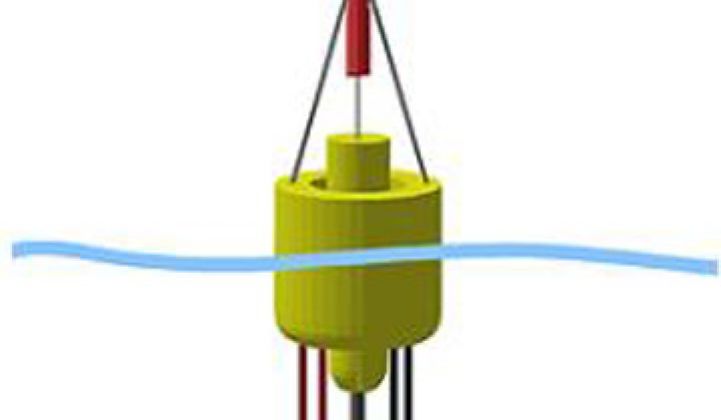“The largest energy storage device on the planet is the Atlantic Ocean,” said Andrew Parrish, Managing Director of Wavebob, one of the most advanced wave energy companies in the world. “The Atlantic is the battery for the planet.”
Ocean energy is expected to put 45 prototypes in the water in 2010 and 2011, according to a new report from Emerging Energy Research (EER). The report predicts ocean energy will go from an annual installation of 50 megawatts per year in 2015 to at least a gigawatt per year after 2026 and could reach a 2030 cumulative installed capacity of seventeen gigawatts.
“If you look at the wave energy sector,” Parrish said, “there are probably two hundred different companies trying to do wave energy.” While “there has been little evidence” of a particular technology’s superiority, Parrish said, “the evidence is converging on a Point Absorber.” The EER report found that Point Absorbers make up more than a third of those currently vended while none of the others constitute as much as a fifth.
Wavebob, Parrish said, offers two advantages. First, it floats, so “it does not have the capital cost and maintenance obstacles of seabed installation.” It has “minimal impact on the local habitat and environment” and is “axially symmetric so you can absorb energy from all directions.”
“Where we would be different to other point absorbers,” Parrish said, is that “the device oscillates and resonates in time with a particular wave climate” because at its center is a patented “neutrally buoyant mass of water” in a cylinder. Parrish called this Wavebob’s “key innovation.”
The cylinder holds enough water mass to capture the power of normal ocean swells, but when the sea becomes tempestuous, it can be emptied. Devices that cannot purge their mass can bang themselves to the point of dysfunction in harsh ocean conditions. Wavebob can reduce itself to a float and ride out storms.
A “key design characteristic,” Parrish said, is that Wavebob “be capable of being maintained and operated at sea.” This is Wavebob’s second competitive advantage.
“We’re designing the equivalent of a ship,” Parrish said. “It’s something that has to be robust, has to be designed to marine codes” and can “cope with people being on it.” In the event of a performance failure, “we can put operators on the machine, below deck where we have our operational system.”
Any other design would be commercially impractical. “If you have to disconnect it from its moorings and bring it back to shore, you’re now incurring huge costs, you’re now subject to particular weather windows,” Parrish explained. “Your production and your output and your revenue are gone.”
Wavebob was patented in 1999 by Irish physicist and environmental consultant William Dick. Parrish came aboard in 2006. “The challenge that William gave me was to take the work that he had done,” Parrish said, “and bring it to the marketplace.”
Parrish took the company from two employees to its present team of 23 scientists and engineers. He then developed a “robust engineering development plan, a systems engineering methodology, which has come directly out of the U.S. aerospace and defense sector.” It is “about engaging at the earliest stage with the end user, capturing their requirements.”
The methodology makes Parrish able to tell partners, “This is where we are and this is how we are going to get to the next level.” It is what makes Wavebob, Parrish said, “an innovation company and not an invention company.”
The team and the methodology have allowed Parrish to engage partners who understand systems engineering like Vattenfall, Chevron, Lockheed Martin and the U.S. Navy.
“They recognize the potential of our technology. We might not be fully commercial yet. We’ve got a couple of years of R&D ahead of us. But what is apparent is that the potential of our technology will exceed anybody else in the space.”
Wavebob has “set up a joint venture company with Vattenfall in Ireland, which is called Tonn Energy ('tonn' being the Irish word for wave),” Parrish said. “Tonn Energy has a mission to develop a 250-megawatt wave farm off the west coast of Ireland. To our understanding, that’s the largest planned wave farm in the world.”
Wavebob is also working with the oil industry on powering offshore oil platforms. “The ability to generate electricity from the waves that surround them instead of using expensive diesel, this is a commercial game for them," Parrish said. Chevron is an investor in the company and has been working with WaveBob.
Parrish estimated the present cost of wave energy at 30 cents per kilowatt-hour. “This industry is where the wind industry was 25 years ago,” he said. “Your iPad is $499 now; it will be $200 next year. In the same way, we’re expensive now but as the technology matures and scales, the cost will become competitive.” Studies show, Parrish said, “the cost curve for wave energy will fall between onshore and offshore wind.”
“Something that excites me a lot right now is that Wavebob has an office in the States and has just secured DOE funding,” Parrish concluded. “Wave energy has been a European thing.” Now, he said, “marine hydrokinetics is on Steven Chu’s agenda,” Parrish explained. “This is where the U.S. is recognized as being exceptional. When you put your mind to doing something, things happen.” He smiled. “We can see the U.S. being the driving force in the next phase of our commercial endeavor.”



